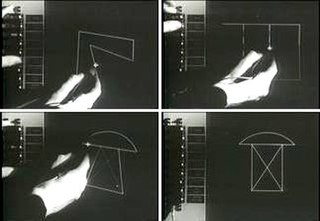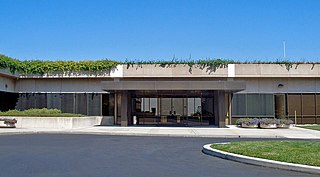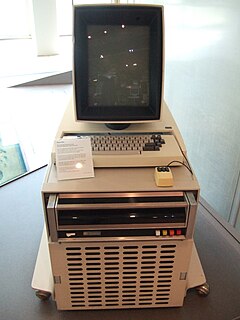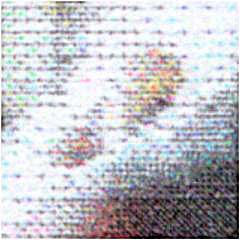Related Research Articles

The graphical user interface is a form of user interface that allows users to interact with electronic devices through graphical icons and audio indicator such as primary notation, instead of text-based user interfaces, typed command labels or text navigation. GUIs were introduced in reaction to the perceived steep learning curve of command-line interfaces (CLIs), which require commands to be typed on a computer keyboard.

The history of the graphical user interface, understood as the use of graphic icons and a pointing device to control a computer, covers a five-decade span of incremental refinements, built on some constant core principles. Several vendors have created their own windowing systems based on independent code, but with basic elements in common that define the WIMP "window, icon, menu and pointing device" paradigm.
Mesa is a programming language developed in the late 1970s at the Xerox Palo Alto Research Center in Palo Alto, California, United States. The language name was a pun based upon the programming language catchphrases of the time, because Mesa is a "high level" programming language.
In computing, What You See Is What You Get is a system where editing software allows content to be edited in a form that resembles its appearance when printed or displayed as a finished product, such as a printed document, web page, or slide presentation.

PARC is a research and development company in Palo Alto, California. Formed in 1970, the company was originally a subsidiary of Xerox, and was tasked with creating computer technology-related products and hardware systems.

Butler W. Lampson, ForMemRS, is an American computer scientist best known for his contributions to the development and implementation of distributed personal computing.

The Xerox Alto is the first computer designed from its inception to support an operating system based on a graphical user interface (GUI), later using the desktop metaphor. The first machines were introduced on 1 March 1973, a decade before mass-market GUI machines became available.

The Star workstation, officially named Xerox 8010 Information System, was the first commercial system to incorporate various technologies that have since become standard in personal computers, including a bitmapped display, a window-based graphical user interface, icons, folders, mouse (two-button), Ethernet networking, file servers, print servers, and e-mail.
A blitter is a circuit, sometimes as a coprocessor or a logic block on a microprocessor, dedicated to the rapid movement and modification of data within a computer's memory. A blitter can copy large quantities of data from one memory area to another relatively quickly, and in parallel with the CPU, while freeing up the CPU's more complex capabilities for other operations. A typical use for a blitter is the movement of a bitmap, such as windows and fonts in a graphical user interface or images and backgrounds in a 2D video game. The name comes from the bit blit operation of the 1973 Xerox Alto, which stands for bit-block transfer. A blit operation is more than a memory copy, because it can involve data that's not byte aligned, handling transparent pixels, and various ways of combining the source and destination data.

The Hercules Graphics Card (HGC) is a computer graphics controller made by Hercules Computer Technology, Inc. that combines IBM's text-only MDA display standard with a bitmapped graphics mode. This allows the HGC to offer both high-quality text and graphics from a single card. The HGC was very popular, and became a widely supported de facto display standard on IBM PC compatibles connected to a monochrome monitor. The HGC standard was used long after more technically capable systems had entered the market, especially on dual-monitor setups.

In computing, a window is a graphical control element. It consists of a visual area containing some of the graphical user interface of the program it belongs to and is framed by a window decoration. It usually has a rectangular shape that can overlap with the area of other windows. It displays the output of and may allow input to one or more processes.

Dots per inch is a measure of spatial printing, video or image scanner dot density, in particular the number of individual dots that can be placed in a line within the span of 1 inch (2.54 cm). Similarly, the more newly introduced dots per centimeter refers to the number of individual dots that can be placed within a line of 1 centimeter (≈ 0.393 in).
Text mode is a computer display mode in which content is internally represented on a computer screen in terms of characters rather than individual pixels. Typically, the screen consists of a uniform rectangular grid of character cells, each of which contains one of the characters of a character set. Text mode is contrasted to all points addressable (APA) mode or other kinds of computer graphics modes.

Lawrence Gordon Tesler was an American computer scientist who worked in the field of human–computer interaction. Tesler worked at Xerox PARC, Apple, Amazon, and Yahoo!

Robert William Taylor, known as Bob Taylor, was an American Internet pioneer, who led teams that made major contributions to the personal computer, and other related technologies. He was director of ARPA's Information Processing Techniques Office from 1965 through 1969, founder and later manager of Xerox PARC's Computer Science Laboratory from 1970 through 1983, and founder and manager of Digital Equipment Corporation's Systems Research Center until 1996.
Gypsy was the first document preparation system based on a mouse and graphical user interface to take advantage of those technologies to virtually eliminate modes. Its operation would be familiar to any user of a modern personal computer. It was the second WYSIWYG document preparation program, a successor to the ground-breaking Bravo on the seminal Xerox Alto personal computer.

Charles Patrick "Chuck" Thacker was an American pioneer computer designer. He worked on the Xerox Alto, which is the first computer that used a mouse-driven Graphical User Interface.
Resolution independence is where elements on a computer screen are rendered at sizes independent from the pixel grid, resulting in a graphical user interface that is displayed at a consistent size, regardless of the resolution of the screen.

Retina display is a brand name used by Apple for its series of IPS LCD and OLED displays that have a higher pixel density than traditional Apple displays. Apple applied to register the term "Retina" as a trademark with regards to computers and mobile devices with the United States Patent and Trademark Office, Canadian Intellectual Property Office. The applications were approved in 2012 and 2014 respectively. The Canadian application cited a 2010 application in Jamaica.
References
- 1 2 Borenstein, Nathaniel S. (1991). Programming as if people mattered : friendly programs, software engineering, and other noble delusions (4. print. ed.). Princeton, N.J.: Princeton University Press. pp. 132. ISBN 9780691087528.
- ↑ "BravoX". IEEE Bushy Tree. Retrieved 2017-05-16.
- Lampson, Butler (1979). "Bravo Manual". Alto User's Handbook. Xerox PARC. pp. 31–62.